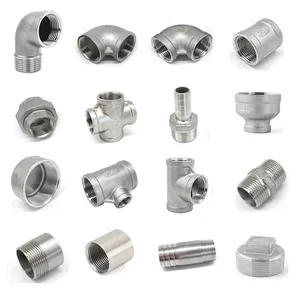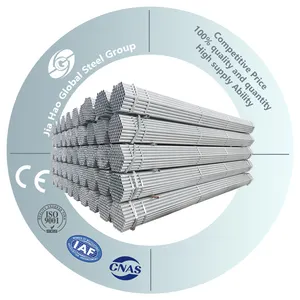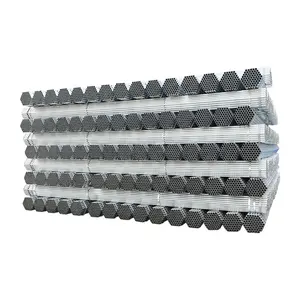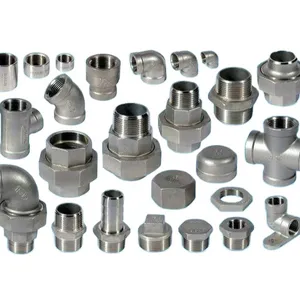A galvanized steel pipe with threads at both ends serves as a versatile and essential component in numerous industries, prized for its resilience and straightforward connectivity, thanks to its galvanization and dual-threaded configuration.
Assortment and Uses of Galvanized Steel Pipes
Within the spectrum of galvanized steel pipes with threads at both ends, there exists a variety designed for distinct purposes. Take the middle class sch40 galvanized steel pipes, which are sufficiently sturdy for moderate-pressure tasks like water transport and air systems, while also being adaptable for intricate layouts. Their uniform wall thickness guarantees consistent performance across various environments. Galvanized steel pipes from China with threaded ends are noted for their affordability and dependability, especially in structural roles such as support columns and barriers, where uniformity is key. The threading's versatility, particularly the NPT standard, ensures compatibility with numerous fittings, broadening their applicability in diverse industrial networks.
Structural and Material Characteristics
The robustness of a galvanized steel pipe with threads at both ends stems from its carefully engineered features. The pipe's cylindrical shape is designed to withstand substantial internal pressure. Precision-engineered threads at each end enable a firm attachment to other pipes, fixtures, or valves. Sealants enhance these connections, filling thread gaps to avert leaks and maintain system integrity across various pressures and temperatures. The design of these pipes accommodates dynamic environments where modifications and upkeep are routine.
Materials and Their Qualities
Steel, chosen for its superior tensile strength, resilience, and formability, is the primary substance in these pipes. The galvanization process, which coats the steel in zinc, markedly increases the pipe's resistance to corrosion, thereby prolonging its lifespan. The selection between non-alloy and alloy steel, as well as the specific galvanization method, is dictated by the intended use of the pipe, considering the required robustness, flexibility, and durability. The materials and their properties are carefully selected to ensure the pipes endure the rigorous conditions of industrial usage.
Commercial Utilization and Applications
Galvanized steel pipes with threads at both ends are fundamental to sectors like construction, manufacturing, and agriculture. In construction, they form stable structures and dependable plumbing networks. Manufacturers employ these pipes in high-pressure transport systems for fluids, gases, and particulate matter. In agriculture, they function as irrigation conduits and as structural elements in greenhouses. The oil and gas industry depends on these pipes for the secure transit of products from extraction points to refineries. Their ability to resist industrial wear and tear translates into commercial benefits by diminishing maintenance expenses and bolstering system dependability.
Roles and Responsibilities
The chief role of galvanized steel pipes with threads at both ends is to ensure the safe movement of various materials. They are crafted to manage liquids, gases, and semi-solids, performing dependably under diverse pressures and temperatures. The threading facilitates swift and effortless assembly, disassembly, and reconfiguration of piping systems, crucial for industries that demand operational flexibility. This functional adaptability is a pivotal feature of the pipes' design, enabling them to satisfy the intricate requirements of contemporary industrial tasks.
Unique Attributes and Capabilities
These pipes distinguish themselves with their corrosion-resistant zinc layer and the precision of their threading. The threads at both ends permit a modular approach to pipe systems, allowing for straightforward adjustments in length and direction. This flexibility is a notable benefit over non-threaded pipes, which offer less versatility post-installation. Their compatibility with various fittings and resilience to environmental stressors are additional unique traits that render these pipes highly desirable in the marketplace.
Advantages and Favorable Outcomes
The adoption of galvanized steel pipes with threads at both ends yields numerous advantages. They offer a durable solution for industrial setups, curtailing the need for frequent replacements. The galvanization process protects the pipes from rust over prolonged periods, while the threading ensures tight connections, averting leaks and preserving the purity of transported substances. These pipes contribute to safer industrial settings and more streamlined operations, potentially leading to heightened productivity and profitability.
Guidelines for Effective Usage and Operation
To operate galvanized steel pipes with threads at both ends effectively, it is vital to maintain clean and intact threads. Proper sealing is essential to prevent leakage. When choosing the appropriate pipe, consider the nature of the substances being conveyed, the environmental conditions, and the mechanical stresses involved. For upkeep and maintenance, routine inspections are advised to detect any issues promptly. Installations should comply with industry norms, including suitable supports to mitigate structural strain.
Intended Recipients and Their Requirements
The intended clientele for galvanized steel pipes with threads at both ends comprises industries in need of high-caliber, resilient piping solutions that can endure severe conditions. These sectors prize the pipes' reliability, adaptability, and longevity, which in turn guarantees the smooth and efficient continuation of their operations. The product's design addresses these requirements by offering a robust, flexible, and low-maintenance option.
What are the benefits of using galvanized steel pipes threaded on both ends?
The benefits of employing galvanized steel pipes with threads at both ends include their augmented durability, resistance to corrosion, ease of installation, and minimal upkeep. These qualities render them a cost-effective option for intricate industrial piping systems, ensuring long-term dependability.
Are galvanized steel pipes environmentally friendly?
Galvanized steel pipes are considered environmentally friendly due to their longevity and recyclability. The zinc coating prolongs the pipe's life, diminishing the need for frequent replacements and reducing waste. At the end of their service life, these pipes can be recycled, lessening their environmental footprint.
Can galvanized steel pipes be used for drinking water?
Although galvanized steel pipes with threads at both ends are suitable for water transportation, it is imperative to verify that they conform to drinking water safety standards to avert health hazards linked to metal leaching.

































 浙公网安备 33010002000092号
浙公网安备 33010002000092号 浙B2-20120091-4
浙B2-20120091-4